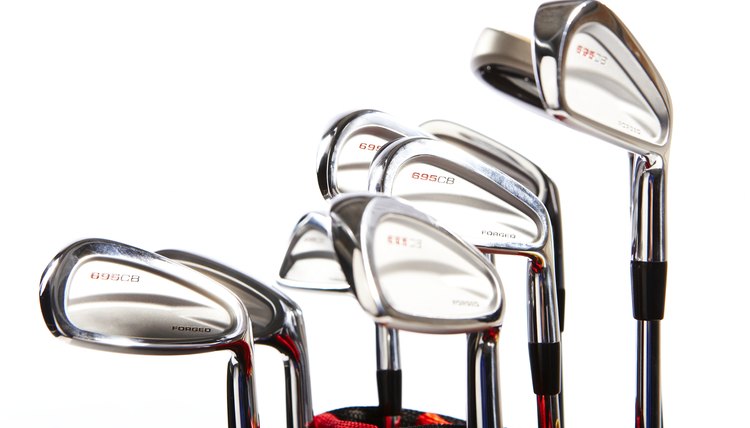List of Different Types of Golf Clubs & Their Uses

Most golf clubs are designed for specific types of shots, although a few have multiple uses. The main differences between the various clubs in your bag are the size and shape of their heads, the length of the shaft and the loft, which is the angle of the club face that primarily determines the height of the shot. Clubs are considered "long" and "medium" when the loft angle is low, and "short" when the loft angle is high.
Driver
The driver is your longest club. Its loft may be as little as 7 degrees or, if you need help getting the ball airborne, as much as 11 degrees. The head is usually made of lightweight titanium in order to maximize its size without becoming too heavy. You use the driver exclusively for tee shots, where it produces maximum height and distance with minimum side spin for straighter shots.
Irons
The irons are for hitting shots from the fairway to the green. Shots from long and medium irons travel farther, while short-iron shots fly higher but for a shorter distance and stop more quickly. With the advent of utility clubs, your iron set may start with the 5-iron, which has a loft of about 30 degrees. The pitching wedge is the shortest iron and it has a loft of about 46 degrees. You also use short irons for chip shots from just off the green.
Irons are typically used by the golfer when his ball is fewer than 200 yards from the green.
Irons are numbered 1 through 9 and possess a higher degree of loft than the woods, with the 9-iron having the most. 1-, 2-, and 3-irons are called long irons and have little loft, meaning they can send the golf ball the farthest.
The 4-, 5-, and 6-irons are known as the middle irons and are used when the ball is about 150 to 170 yards from the hole.
The short irons are the 7-, 8-, and 9-irons and get the ball in the air quickly due to their loft.
The normal golf set contains a 3- through 9-iron because the 1- and 2-irons are the most difficult to master.
Fairway Woods
Despite their name, fairway woods are no longer made of wood and you don’t necessarily use them in the fairway.
Sometimes called “fairway metals,” these clubs are usually made of stainless steel. The shaft is set off center in the large head and the flattened bottom lets the head slide over the grass when you take your shot.
Use them for fairway shots that are beyond the range of your irons, and on tee shots when you need more control of the ball. Their lofts of 12 to 20 degrees produce higher, softer shots than the driver and allow you to shape shots more easily.
Utility Clubs
Utility clubs or hybrids typically have lofts of 17 to 23 degrees and are a cross between fairway woods and long irons.
Club manufacturers initially marketed them for long shots out of the rough, which may be bushes, trees or other landscaping next to the fairway and greens, or from other poor lies.
The clubs' design makes it so easy to hit the ball that they've replaced long irons in many golfer’s bags.
Wedges
You use specialty wedges like sand, lob and gap wedges for short pitches from the fairway and blasting out of sand bunkers. They fall just below the pitching wedge in loft, at around 50 to 64 degrees.
Golfers usually select a pitching wedge when the shot is as far as 130 yards to the green and a sand wedge to escape from bunkers and very tall grass.
The wedge club heads have various amounts of bounce, a quality produced by the thickness and angle of the sole of the club. More bounce is desirable for shots from sand or soft turf, but pitch shots from firmer ground are easier to hit with clubs with little or no bounce.
Golfers often carry several wedges with different lofts and bounce angles for use from a variety of distances and lie conditions:
Pitching Wedge: Golfers usually select a pitching wedge when the shot is as far as 130 yards to the green. A pitching wedge has a loft between 46 to 51 degrees.
Gap Wedge: A gap wedge allows the golfer to take a full swing and hit the ball about 110 yards.
Lob Wedge: The lob wedge is chosen when the ball needs to rise quickly to clear a hazard but not have to carry a great distance. Golf sets generally come with a pitching wedge; other wedges must be purchased separately. A lob wedge's loft can be as high as 64 degrees.
Sand Wedge: Golfers use a sand wedge to escape from bunkers and very tall grass.
Putter
Putters are for use on or around green, the putting surface surrounding the hole.
Many putters have plastic or soft metal face inserts to give them better feel and for rolling the ball more smoothly.
Putters have flat faces with only about 4 degrees loft to keep the ball from bouncing up when you strike it. And the standard putter is about 34 to 35 inches tall.
The Belly Putter and Broomstick Putter: The belly putter and broomstick putter are much taller clubs and are used to give the golfer a better putting stroke when the player has problems using a standard putter.
Writer Bio
Don Patton began writing after retiring from an engineering career in 2006. He holds a Bachelor of Science in electrical engineering from the University of California at Berkeley and continued with graduate study in software engineering.
